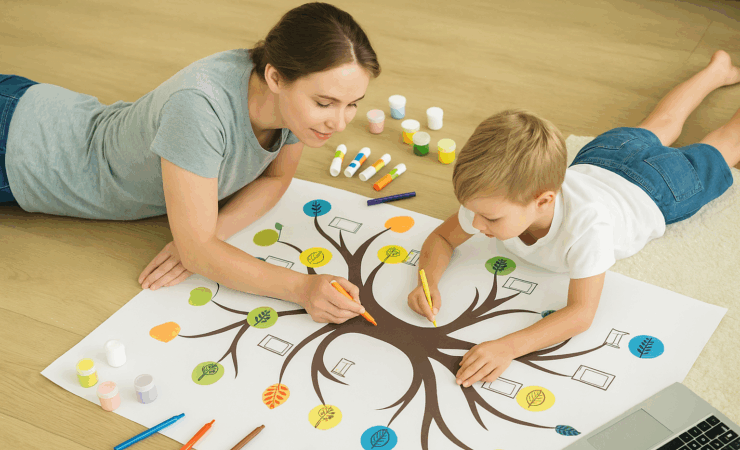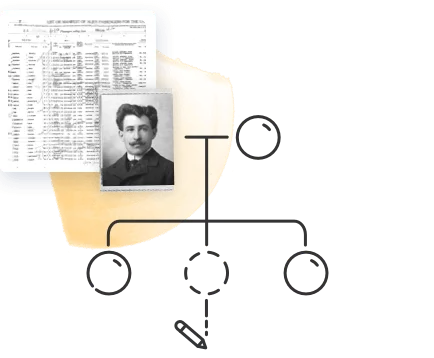
Whether it’s a school project, a bonding moment with grandparents, or just a fun weekend activity, building a family tree can be a meaningful and engaging experience for any kid. No matter where or how it’s made, a family tree can introduce them to their roots, encourage curiosity, and offer a hands-on way to connect with their own, unique story.
For parents, teachers, or older relatives, guiding a child through this process is a fun opportunity to pass down stories, explain traditions, bond, and maybe even learn some exciting new pieces of family history together. Try your best to make this process visual and interactive, letting children actually see the tree grow as they add names, stories, and even historical records.
So, whether you’re helping with a classroom assignment or creating a keepsake that can grow branch by branch over the years, let’s explore how to create family trees for children.
Who Is This Guide For?
This blog is especially helpful for:
- Parents helping a child with a school project
- Teachers creating a family history unit in their classrooms
- Grandparents looking to share their story and heritage
- Hobbyists passing genealogy on to the next generation
Key Takeaways:
- Tailor the depth of the tree to the child’s age and purpose (school vs. hobby).
- Start with immediate family and work outward, using names, photos, and fun facts.
- Use storytelling and creativity to make it engaging, not overwhelming.
- Keep it visual: posters, drawings, or printable templates work well.
- The MyHeritage tree builder makes for an easy, interactive, and visual way to add relatives and even explore historical records together.
How Do You Start a Family Tree With a Child?
Like any strong tree, it begins at the root. The best way to begin is by keeping it simple and setting a foundation. You don’t need to dive into generations of data right away or see just how far your tree stretches to the oldest known relative.
Start with the people the child already knows — parents, grandparents, maybe a few aunts or uncles — and let the tree grow naturally from there.
Branches will arrive, but start with a good, solid trunk.
What’s the Best Age to Begin a Family Tree?
There’s no perfect age to introduce a child to their family tree, but kids around age 6 and up can usually understand the basics of family relationships. Younger children may enjoy drawing or naming relatives, while older ones can grasp dates, locations, and cultural context.
What that essentially means is it’s up to you, but it also means that there are multiple types of family trees. Some focus on the visuals, crafts, and old pictures, while others concentrate on key dates, historical documents, and exciting stories.
Start With a Conversation
The easiest way to assess a child’s interest is by talking. Ask questions like:
- Who do you know in our family?
- Do you know where Grandma or Grandpa was born?
- Have you heard any family stories or nicknames?
Jot these answers down and encourage kids to add their own memories or facts, no matter how small. A comment like “Uncle Joe loves fishing” might not seem like genealogy, but it’s a part of your family’s identity, and it helps explore the unique stories of those you might find later.
Use a Template or Visual Aid
For many children, visuals help make the concept real. To help in that aspect, try:
- Drawing a tree on a poster or whiteboard
- Using a printed worksheet with blank spaces
- Starting a digital family tree with drag-and-drop tools
Another option to explore online is creating a family tree with MyHeritage, which lets children watch their tree expand as new relatives are added. You can even attach photos, documents, or short notes, which is great for keeping things both educational and fun.
How Can You Make It Fun and Meaningful for Kids?
To keep a child engaged in family history, it helps to blend facts with creativity, storytelling, and imagination. The idea is always to look beyond the data to find the story, because, whether true or completely out of left field, kids are remarkable storytellers.
Let Them Be the Archivist
Letting kids lead the charge is always a good piece of advice in projects like this. Give them “special access” to family photos, old birthday cards, or even audio recordings, and ask them to:
- Match names to faces in old photographs
- Interview grandparents or older relatives
- Create a “Family Fact File” with favorite colors, jobs, or foods of different relatives
These kinds of activities help kids understand that their relatives were real people, not just names in boxes. Maybe they even shared common interests, such as reading or sports.
Turn It Into a Craft or Game
For younger children especially, art and play can make the process much more memorable:
- Create a fingerprint family tree using ink and a blank poster
- Use cut-out leaves or apples with names written on them
- Try a scavenger hunt for “family clues” around the house (photos, souvenirs, objects with stories)
Even coloring in a tree chart can be a fun step that turns learning into a bonding experience.
Use Tools That Grow With Them
If you’re using an online tree builder like MyHeritage, you can start simple with parents, grandparents, and siblings (the relatives they might more often see), and gradually expand the tree together. It’s a great way to build curiosity over time. You might find yourself exploring records, searching for immigration documents, or even discovering unknown relatives.
What’s more, this visual layout lets children see their heritage come together in real time. That means it isn’t a one-off project, but an ongoing experience.
What Should You Do About Missing or Sensitive Information?
Every family tree has gaps, and sometimes those gaps are there for a reason. Whether it’s an unknown parent, an estranged relative, or a complicated part of the past, it’s important to approach these topics gently when working with children.
Be Honest, But Keep It Age-Appropriate
You don’t have to explain every detail, especially for younger kids. It’s okay to say:
- “We don’t know who that person was yet.”
- “That’s something we’ll learn more about together later.”
- “This part of the family has a difficult story, but it’s still part of who we are.”
The main goal is to avoid creating shame or fear around the unknown.
Use These Moments to Teach Empathy
Missing information is an opportunity to help children understand that families (and history) are complex topics to explore. You can try to explain that:
- Some people lost records in wars or migrations
- Some family members may have gone by different names or changed identities
- Not every story is happy, but every story matters
These conversations can build emotional intelligence and help children view family history with compassion rather than judgment.
Leave Space to Return Later
If something feels too difficult to explain right now, that’s okay. Just leave a placeholder in the tree, or add a note like “More to discover here.” This leaves the storybook open to return to, making space for the child (or their future self) to pick it back up later.
What Are Some Creative Add-Ons for a Child’s Family Tree?
Once the basic family tree is built, there is a lot of opportunity to make it unique. Kids love personalization, and a few creative additions can turn their tree into something they’ll want to revisit and possibly even show off to friends or the rest of their family. These extras help turn genealogy into an art project, a game, or a storytelling adventure.
Add a Family Motto or Crest
Encourage your child to invent (or research!) a family motto. It could be a quote, a song lyric, or a meaningful phrase passed down from a grandparent. You can even design a family crest together using drawings or digital art platforms, incorporating symbols that represent favorite foods, shared hobbies, or hometowns. However small, these fun add-ons can give kids a sense of family identity beyond names and dates.
Create a Time Capsule
Have your child write a letter to their future self or a future family member. They can include:
- A drawing of their family tree
- A favorite memory involving a family member
- Predictions for how the tree (and the world!) might look in 50 years
Store it in a keepsake folder or upload it to a digital archive for safekeeping. Revisiting it later can be an exciting moment of reflection, growth, and maybe a bit of nostalgia.
Make a Storybook
Turn the tree into a storytelling project. Help your child choose one or two relatives and write a short story about them. It can be based on real details or imagined adventures.
The goal is to make history feel alive.
One child might write about “Great Grandpa Jameson’s first job in the bakery,” while another imagines “Aunt Ingrid as a secret opera singer.” Either way, these stories bring warmth and personality to the tree, and let your child see the stories behind the people.
How Do You Turn a School Assignment Into a Family Keepsake?
What starts as a homework project can easily become something more. A simple tree on posterboard or a few notes typed into a digital tool may be the spark that lights a lifelong interest or a memory your child carries for decades.
And in that way, do your best to make it last. If your child draws a family tree, help them laminate it or store it in a folder to revisit later. If they record interviews, upload the audio. Even their earliest spelling of “Great Grandma Rosa” with extremely squiggly letters is worth holding onto. These first steps in family history can become heirlooms in their own right.
Let the Tree Grow With Them
You don’t have to finish a family tree all in one sitting. Add to the tree gradually — on birthdays, around holidays, or during visits with extended family.
Use it as a living document of people and experiences.
A user once shared that their daughter started a family tree in second grade with just six names. A decade later, she had nearly 200 relatives listed, with handwritten stories from her grandfather pasted in like scrapbook pages. What began as a worksheet turned into a binder passed around at family reunions.
What’s the Most Important Part of a Child’s Family Tree?
More than anything, remind yourself and your child: this is meant to be fun. It’s okay if there are gaps, messy lines, or a few confusing branches. What matters is the connection between past and present, between child and family, and between names on a page and the stories we share about them. It’s not how far back you go, but how connected you feel while doing it.
A child’s family tree is an opportunity to ask questions, share stories, and celebrate the people who have shaped them. Whether it’s a school project or a multigenerational keepsake, the joy is in the discovery, the bond, and the experience.
To get started on your very own family tree, check out the MyHeritage website.
FAQs on Family Tree Creation with Children
How many generations should we include in a child’s family tree?
Start by keeping it simple. For young children or school projects, 2–3 generations is usually enough—parents, grandparents, and great-grandparents, if possible. Older kids may enjoy going deeper, especially if they’re curious about immigration, culture, or family traditions.
What if we don’t know much about one side of the family?
That’s perfectly okay. Include what you do know, and mark unknowns with notes like “still learning” or “more to discover.” This can be a great moment to reach out to extended family or to explore historical records together.
Should we include stepfamilies or adoptive relatives?
Yes. A family tree should reflect the people who are important in the child’s life, not just biological connections. Include adoptive parents, stepparents, and chosen family, and note relationships clearly if needed.
Can kids use online tools safely for genealogy?
Yes, with guidance. Tools like MyHeritage enable the creation of private and secure family trees. For younger children, an adult should set up the account and explore the site together to ensure a safe and age-appropriate experience.
What if the child loses interest partway through?
That’s normal! Let the project rest and come back to it later. Keep it fun and flexible. Even if they don’t finish right away, those early conversations and connections will leave a lasting impression.




